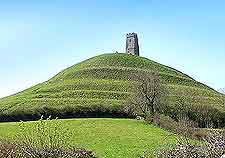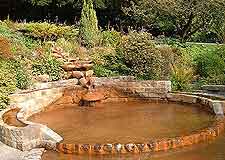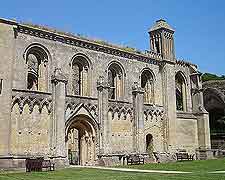Glastonbury History Facts and Timeline
(Glastonbury, Somerset, England)

The small Somerset town of Glastonbury is surrounded by myths and legends. Even its earliest origins are subject to much debate.
One legend has it that Joseph brought the Holy Grail to Britain and was granted land by its local ruler. On his arrival, Joseph stuck a thorn staff into the ground, which burst into bloom. He is said to have established England's first church at Glastonbury, thus founding the town. The mystery of the Holy Grail remains just that, although some believe it to be still buried beneath Glastonbury Tor, in what is known today as the Chalice Well.
In the second legend, Glastonbury's earliest history is closely linked with that of King Arthur. Indeed, a nearby fort at South Cadbury is thought to have been the site of his castle at Camelot. Arthur may have lived around the early 6th century AD. Some believe that Arthur was buried on the Tor, which was then the Isle of Avalon and surrounded by the flooded Somerset Levels.
What is known, however, is that the Saxons conquered the county of Somerset in the 7th century AD. Their king put up a stone church, which forms the west end of the nave of Glastonbury Abbey. Around it, grew a small settlement. The abbey gained much wealth, so that by the time William the Conqueror arrived, it owned a considerable amount of land.

Medieval Times
Under the Normans, Glastonbury saw many changes during this period of history. New, much grander buildings were added to the abbey and a new Norman abbot was appointed. By 1086, it was recorded as being the richest monastery in the country. Unfortunately, such grandeur was to be short-lived. In 1184, a massive fire raged through its buildings, destroying many monastic treasures. The story goes that, in an attempt to raise money from pilgrims to rebuild it, the monks excavated and unearthed the bodies of King Arthur and Queen Guinevere.
During the Middle Ages, Glastonbury was a busy market town. There had been a market here since 1189 and most of the town's population probably lived around a market place that was situated to the north-west of the monastic precincts. At that time, Glastonbury Abbey was second in wealth only to Westminster Abbey in
London. As such, it held tremendous power. The economy of the town was heavily dependent on the abbey. Not only was it a centre for pilgrimage, but it also encouraged medieval craftsmen, such as goldsmiths, limners and scriveners, to set up their businesses here.
Early Modern History
All this was to change in the 16th century, when monasteries such as the one found in Glastonbury fell victim to King Henry VIII's religious reforms. The abbey's closure in 1539 had a profound effect on the town. The abbot's refusal to submit ended with his execution and that of two other monks. All that remained of the sacked abbey was the Abbot's Kitchen, which still survives to this day.

In the 17th century, Glastonbury's fortune was revived a little by the arrival of the cloth industry. There was even a short period during the 18th century when it enjoyed a reputation as a spa town. A pump room was built, but an outbreak of smallpox in 1753 did nothing to attract prospective visitors.
19th to 20th centuries
During the 19th century, the town slowly grew, acquiring some public buildings, such as the Town Hall in 1814 and the Market Cross. Then, in 1854, a railway from Bridgwater was opened.
In the 20th century, Glastonbury became a popular tourist destination. In 1959, the Chalice Well was opened, followed in the late 1970s by the Somerset Rural Life Museum. However, what has succeeded most in putting the town on the map is its Festival. First held in 1971, the Glastonbury Festival continues to attract thousands of visitors and musicians. The town is also at the centre of a New Age movement in Britain.
 The small Somerset town of Glastonbury is surrounded by myths and legends. Even its earliest origins are subject to much debate.
The small Somerset town of Glastonbury is surrounded by myths and legends. Even its earliest origins are subject to much debate.
 In the 17th century, Glastonbury's fortune was revived a little by the arrival of the cloth industry. There was even a short period during the 18th century when it enjoyed a reputation as a spa town. A pump room was built, but an outbreak of smallpox in 1753 did nothing to attract prospective visitors.
In the 17th century, Glastonbury's fortune was revived a little by the arrival of the cloth industry. There was even a short period during the 18th century when it enjoyed a reputation as a spa town. A pump room was built, but an outbreak of smallpox in 1753 did nothing to attract prospective visitors.